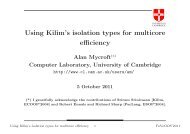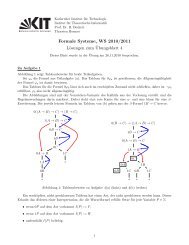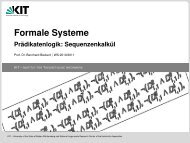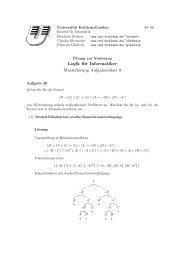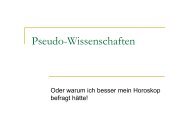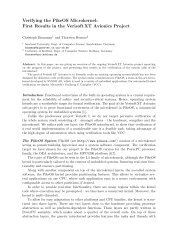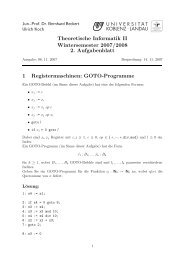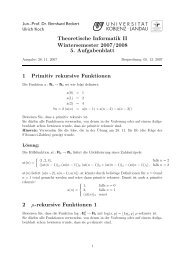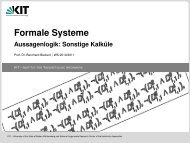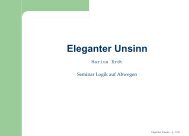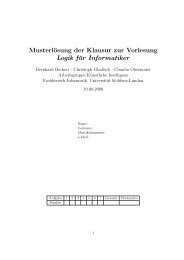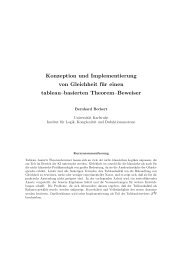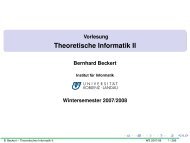Deductive Verification of System Software in the Verisoft XT Project
Deductive Verification of System Software in the Verisoft XT Project
Deductive Verification of System Software in the Verisoft XT Project
You also want an ePaper? Increase the reach of your titles
YUMPU automatically turns print PDFs into web optimized ePapers that Google loves.
trigger<strong>in</strong>g annotation can be viewed as a logic programm<strong>in</strong>g language<br />
used to implement a <strong>the</strong>ory to be executed by <strong>the</strong> SMT<br />
solver. Of course one could also implement <strong>the</strong> <strong>the</strong>ory <strong>in</strong>side an<br />
SMT solver, which would likely be much more efficient, but <strong>the</strong><br />
implementation would be much harder. Given how fast such a<br />
<strong>the</strong>ory evolves dur<strong>in</strong>g development <strong>of</strong> a verification tool, it seems<br />
counterproductive <strong>in</strong> most cases.<br />
The problems stemm<strong>in</strong>g from deductive s<strong>of</strong>tware verification<br />
are quite different from <strong>the</strong> ground SMT problems that mostly<br />
result from hardware verification. For example, <strong>the</strong> number <strong>of</strong><br />
conflicts per time unit that <strong>the</strong> solver f<strong>in</strong>ds tends to a thousand<br />
times smaller for s<strong>of</strong>tware. This is not enough to calibrate<br />
usual heuristics for order<strong>in</strong>g propositional assignments. Also <strong>the</strong><br />
implementation <strong>of</strong> various <strong>in</strong>dices for E-match<strong>in</strong>g is crucial for<br />
performance. Z3 is very good with ground SMT problems, and<br />
it is def<strong>in</strong>itely <strong>the</strong> lead<strong>in</strong>g solver for quantified queries. This is<br />
partially a result <strong>of</strong> close collaboration between <strong>the</strong> authors <strong>of</strong><br />
Z3 and researchers us<strong>in</strong>g it for s<strong>of</strong>tware verification.<br />
4 Conclusion<br />
The Hypervisor sub-project <strong>in</strong>volves up to 20 people work<strong>in</strong>g,<br />
mostly on specification <strong>of</strong> <strong>the</strong> Hyper-V, for three years, mak<strong>in</strong>g<br />
it one <strong>of</strong> <strong>the</strong> largest formal verification efforts ever attempted.<br />
While <strong>the</strong> Avionics sub-project is smaller, it still <strong>in</strong>volves <strong>the</strong> full<br />
functional verification <strong>of</strong> thousands <strong>of</strong> l<strong>in</strong>es <strong>of</strong> complex C code.<br />
Based on experience and results from <strong>the</strong> first half <strong>of</strong> <strong>the</strong><br />
project, we can conclude that verify<strong>in</strong>g concurrent system s<strong>of</strong>tware<br />
written <strong>in</strong> C and assembly code is difficult and at <strong>the</strong> edge<br />
<strong>of</strong> <strong>the</strong> state <strong>of</strong> <strong>the</strong> art <strong>of</strong> s<strong>of</strong>tware verification. But given sufficient<br />
resources, it can be done and, consider<strong>in</strong>g <strong>the</strong> importance<br />
<strong>of</strong> correct system s<strong>of</strong>tware, is useful and feasible on an <strong>in</strong>dustrial<br />
scale. The Veris<strong>of</strong>t <strong>XT</strong> project emphasises <strong>the</strong> well-known<br />
fact that s<strong>of</strong>tware verification is one <strong>of</strong> <strong>the</strong> most important applications<br />
<strong>of</strong> automated deduction. The project’s success relies<br />
heavily on recent advances <strong>in</strong> deduction technology.<br />
References<br />
[1] Wolfgang Ahrendt, Bernhard Beckert, Mart<strong>in</strong> Giese, and Philipp<br />
Rümmer. Practical aspects <strong>of</strong> automated deduction for program<br />
verification. KI, 2009. In this issue.<br />
[2] Mike Barnett, K. Rustan M. Le<strong>in</strong>o, and Wolfram Schulte. The<br />
Spec# programm<strong>in</strong>g system: An overview. In Proc. CASSIS<br />
2004, LNCS 3362, pages 49–69. Spr<strong>in</strong>ger, 2005.<br />
[3] Christoph Baumann, Bernhard Beckert, Holger Blasum, and<br />
Thorsten Bormer. Better avionics s<strong>of</strong>tware reliability by code<br />
verification. In Proc. Embedded World Conference, 2009.<br />
[4] Christoph Baumann, Bernhard Beckert, Holger Blasum, and<br />
Thorsten Bormer. Formal verification <strong>of</strong> a microkernel used <strong>in</strong><br />
dependable s<strong>of</strong>tware systems. In Proc. SAFECOMP 2009, LNCS.<br />
Spr<strong>in</strong>ger, 2009. To appear.<br />
[5] Sascha Böhme, Micha̷l Moskal, Wolfram Schulte, and Burkhart<br />
Wolff. HOL-Boogie: An <strong>in</strong>teractive prover-backend for <strong>the</strong> Verifiy<strong>in</strong>g<br />
C Compiler. Journal <strong>of</strong> Automated Reason<strong>in</strong>g, 2009. To<br />
appear.<br />
[6] Ernie Cohen, Markus Dahlweid, Mark Hillebrand, Dirk Le<strong>in</strong>enbach,<br />
Micha̷l Moskal, Thomas Santen, Wolfram Schulte, and<br />
Stephan Tobies. VCC: A practical system for verify<strong>in</strong>g concurrent<br />
C. In Proc. TPHOLs 2009, LNCS 5674, pages 23–42. Spr<strong>in</strong>ger,<br />
2009. Invited paper.<br />
[7] Leonardo de Moura and Nikolaj Bjørner. Z3: An efficient SMT<br />
solver. In Proc. TACAS 2008, LNCS 4963, pages 337–340.<br />
Spr<strong>in</strong>ger, 2008.<br />
[8] Rob DeL<strong>in</strong>e and K. Rustan M. Le<strong>in</strong>o. BoogiePL: A typed procedural<br />
language for check<strong>in</strong>g object-oriented programs. Technical<br />
Report MSR-TR-2005-70, Micros<strong>of</strong>t Research, 2005.<br />
[9] David L. Detlefs, K. Rustan M. Le<strong>in</strong>o, Greg Nelson, and James B.<br />
Saxe. Extended static check<strong>in</strong>g. SRC Research Report 159,<br />
Compaq <strong>System</strong>s Research Center, Palo Alto, 1998.<br />
[10] Cormac Flanagan, K. Rustan M. Le<strong>in</strong>o, Mark Lillibridge, Greg<br />
Nelson, James B. Saxe, and Raymie Stata. Extended static<br />
check<strong>in</strong>g for Java. In Proc. PLDI 2002, SIGPLAN Notices 37,<br />
pages 234–245. ACM, 2002.<br />
[11] Robert Kaiser and Stephan Wagner. Evolution <strong>of</strong> <strong>the</strong> PikeOS<br />
microkernel. In Proc. 1st International Workshop on Microkernels<br />
for Embedded <strong>System</strong>s (MIKES), 2007. Available<br />
at http://ertos.nicta.com.au/publications/papers/<br />
Kuz_Petters_07.pdf.<br />
[12] Shuvendu K. Lahiri and Shaz Qadeer. Back to <strong>the</strong> future: revisit<strong>in</strong>g<br />
precise program verification us<strong>in</strong>g SMT solvers. In Proc.<br />
POPL 2008, pages 171–182. ACM, 2008.<br />
[13] K. Rustan M. Le<strong>in</strong>o and Peter Müller. Object <strong>in</strong>variants <strong>in</strong> dynamic<br />
contexts. In Proc. ECOOP 2008, LNCS 3086. Spr<strong>in</strong>ger,<br />
2004.<br />
Contact<br />
Pr<strong>of</strong>. Dr. Bernhard Beckert<br />
Karlsruhe Institute <strong>of</strong> Technology<br />
Institute for Theoretical Informatics<br />
Am Fasanengarten 5, 76131 Karlsruhe, Germany<br />
Phone: +49 721 608-4025<br />
Email: beckert@kit.de<br />
Micha̷l Moskal<br />
European Micros<strong>of</strong>t Innovation Center<br />
Ritterstrasse 23, 52072 Aachen, Germany<br />
Email: michal.moskal@micros<strong>of</strong>t.com<br />
Bild Bernhard Beckert is a pr<strong>of</strong>essor <strong>of</strong><br />
Application-oriented Formal <strong>Verification</strong><br />
at <strong>the</strong> Karlsruhe Insitute <strong>of</strong> Technology.<br />
His research <strong>in</strong>terests <strong>in</strong>clude automated<br />
deduction, non-classical logics, and formal<br />
methods <strong>in</strong> s<strong>of</strong>tware eng<strong>in</strong>eer<strong>in</strong>g.<br />
Bild Micha̷l Moskal is a researcher at <strong>the</strong> European<br />
Micros<strong>of</strong>t Innovation Center, Aachen,<br />
Germany, closely collaborat<strong>in</strong>g with <strong>the</strong> Research<br />
<strong>in</strong> S<strong>of</strong>tware Eng<strong>in</strong>eer<strong>in</strong>g Group at Micros<strong>of</strong>t<br />
Research, Redmond, USA. He is also<br />
a PhD student at <strong>the</strong> Computer Science Institute<br />
<strong>of</strong> <strong>the</strong> University <strong>of</strong> Wroc̷law, Poland.<br />
His research currently focuses on s<strong>of</strong>tware<br />
verification with SMT and <strong>the</strong> VCC verifier<br />
<strong>in</strong> particular.



